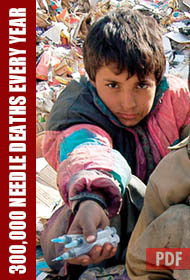Experts Speak Out
Sharps safety has fallen off the radar and there is a complacency to the extent that there will probably be a resurgence in injuries simply because there is no one to strongly advocate [for better technology].
—Mary Foley, RN, MS, PhD, past president, American Nurses Association, Nov. 2010
We know too many health care professionals are still at risk of a sharps injury and that more work needs to be done.
—Karen A. Daley, PhD, MPH, RN, FAAN - President, American Nurses Associantion, Nov. 2010
By ANNETTE M. BARRY – RN, BS, CCRP.
As a Nurse for 35 years I feel great pride to be a part of something so wondrous and ever changing as the medical field. The speed with which our medical science innovations have developed during my nursing career is extraordinary! It has also been wonderful to participate in the attitude changes that have taken place over the years. Patients have become much more active in their health care and thanks to the internet are much more informed when they see a physician. Patients are asking very detailed and intelligent questions and are now used to making information based decisions about their health and are active participants in their health care. Interestingly, we (I include myself) have never really questioned getting our blood drawn. None of us like it (some less than others) and none of us would let anyone poke a hole in us if we didn’t think it was absolutely necessary. So we each reluctantly stick our arms out and hope the person doing it knows what they are doing.
As a nurse I have spent a great deal of time accessing veins. My ego found joy in that I seemed to have the ability to get in a vein on the first try. I had a “visualization” technique I utilized. I was always a little nervous preparing to draw blood because I didn’t want to cause the patient any more discomfort than necessary. More importantly, I knew that once I missed the vein the patient would lose confidence in my ability as a nurse. Even worse, I would lose confidence in myself which would make the second attempt even more difficult. I developed a “3 strikes I’m out” policy. Some of my colleagues have developed the “if I can’t get it (the vein) then no one can” attitude and have stuck a patient many times to obtain a blood sample. As with most professions there are a lot of egos in the medical field.
As a patient I am very fearful of needles. Most blood draws leave me with a large hematoma, sometimes painful due to the clinician penetrating both sides of my vein. I have had a clinician put the tourniquet on my arm so tight it completely cut off my blood supply. On another occasion, the vacutainer tube exploded and my blood was everywhere. I have 2 “good” veins, I am comfortable in a health care setting and I am still fearful to have my blood drawn. I know for many others it can be a nightmare and some lose trust with the entire healthcare industry. The one “tip” I can pass on is that when it comes to blood drawing, credentials mean very little. Practice means everything. Most MD’s and RN’s rarely draw blood. It’s the Medical Assistants or Lab Tech’s that have developed a real talent due to constant practice.
As a nurse I would answer any question a patient would have about the blood drawing process. Most patients did not have any questions and would just stick their arm out to “get it over with”. As a patient I never had any questions because I knew all the terrible things that could happen but felt I had no choice and would just stick my arm out just wanting to “get it over with”. Knowledge, communication, confidence, trust, and proper equipment are all major factors affecting the outcome of the blood collection process. I feel that informing patients of the risks associated with the procedure can enhance the patient and the clinician’s relationship if the technology provides vein entry indication. To have this conversation with devices that do not offer this measure of safety is likely to cause more distress, and perhaps, danger as the patient is apt to make a sudden move when the vacuum tube is introduced and there is no blood flow.
